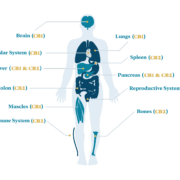The endocannabinoid system of the skin in health and disease: novel perspectives and therapeutic opportunities
Authors
Tamás Bíró,Balázs I. Tóth, György Haskó, Ralf Paus and Pál Pacher
Published in Trends in Pharmacological Sciences
July 2009
Excerpt
The newly discovered endocannabinoid system (ECS; comprising the endogenous lipid mediators endocanna- binoids present in virtually all tissues, their G-protein- coupled cannabinoid receptors, biosynthetic pathways and metabolizing enzymes) has been implicated in multiple regulatory functions both in health and disease. Recent studies have intriguingly suggested the existence of a functional ECS in the skin and implicated it in various biological processes (e.g. proliferation, growth, differen- tiation, apoptosis and cytokine, mediator or hormone production of various cell types of the skin and appen- dages, such as the hair follicle and sebaceous gland). It seems that the main physiological function of the cutaneous ECS is to constitutively control the proper and well-balanced proliferation, differentiation and survi- val, as well as immune competence and/or tolerance, of skin cells. The disruption of this delicate balance might facilitate the development of multiple pathological con- ditions and diseases of the skin (e.g. acne, seborrhea, allergic dermatitis, itch and pain, psoriasis, hair growth disorders, systemic sclerosis and cancer).
Open Access
DOI: 10.1016/j.tips.2009.05.004
Citation:
Bíró, T., Tóth, B. I., Haskó, G., Paus, R., & Pacher, P. (2009). The endocannabinoid system of the skin in health and disease: novel perspectives and therapeutic opportunities. Trends in pharmacological sciences, 30(8), 411-420.


